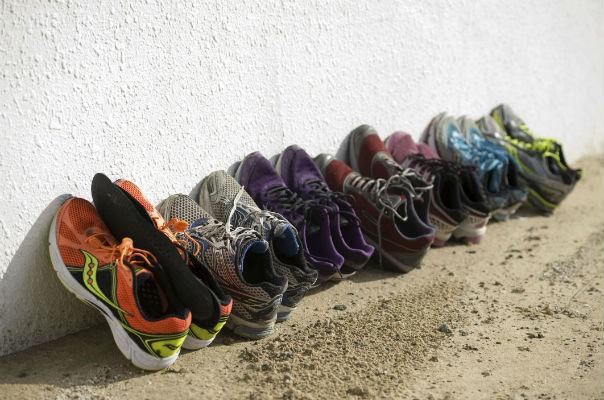
 When it comes to equipment, running is a simple sport—regardless of whether you’re training for a 5K, a half marathon, or a full marathon (or just jogging around the neighborhood). Generally all that’s needed are the right clothes and, more importantly, a good pair of running shoes. But just how long does a quality pair of running kicks last, and how do you know when it’s time to swap in a brand-new pair? (Hint: Don’t ask Forrest!). We dive into the science to ensure your feet stay looking (and feeling!) their best.
When it comes to equipment, running is a simple sport—regardless of whether you’re training for a 5K, a half marathon, or a full marathon (or just jogging around the neighborhood). Generally all that’s needed are the right clothes and, more importantly, a good pair of running shoes. But just how long does a quality pair of running kicks last, and how do you know when it’s time to swap in a brand-new pair? (Hint: Don’t ask Forrest!). We dive into the science to ensure your feet stay looking (and feeling!) their best.
WHAT’S THE DEAL?
When the Greeks ran foot races in the olden days, they usually did so barefoot and naked. Since then, running with clothes and shoes has become more of the norm (phew!), and, with the advent of the modern day athletic shoe, perhaps a little more comfortable.
Developed to be protective and add traction, running shoes have evolved to incorporate lightweight materials that cushion the foot from the trauma of running. Most cushioning comes from EVA foam, a lightweight material injected with air cells designed to absorb impact.
But, like all good things, the foam eventually loses its magic. According to some researchers, that can happen anywhere from 300 to 500 miles after the first wear. For a runner doing five 3-mile runs per week, that comes out to a new pair every five to six months. (Let’s hope Santa comes twice this year!).
Why rush to pick up a new pair? Once that foam wears out, the risk of overuse injuries increases, because the material has lost its ability to absorb shock [1]. While some overuse injuries (like shin splints) are minor, others (like tendinitis) might require more serious treatment. One good way to avoid these issues: Regularly trading in your old shoes for new kicks.
YOUR ACTION PLAN
Why do experts give such a big range for the appropriate time to replace old sneaks? Every runner has a different weight and foot strike, both of which affect the cushioning of shoes in various ways (For instance, a heavier runner who runs on their heels may wear out the shoe cushioning faster than a light runner who runs on their toes.). To eliminate all those miles of guesswork, here are some quick signs that those running shoes need to be replaced:
1. Try the press test. Press a thumb into the center of the shoe, where the midsole is. If the midsole feels tough and unyielding (rather than cushy with some “give”), then it may be time for a new pair.
2. Look for signs of creasing in the sole. Look at the midsole, then use your thumb to press on the outsole into the midsole. When the midsole shows heavy compression lines before you press into it, and doesn’t compress much when you press into it, that’s a sign that the cushioning is pretty much worn out.
3. Pay attention to aches and pains. While some say pain is weakness leaving the body, others say it’s an indication that something is wrong. A little twinge at the bottom of a foot could be your body’s way of saying that a shoe is past its prime.
4. Compare new shoes with old ones. Trying on an old pair of shoes immediately before trying on a new pair gives runners a direct comparison of which feels better. Once an old pair of shoes stops feeling comfortable, it may be time to change it out.
While many runners these days hit the road barefoot or in minimalist shoes with almost no cushioning at all, those athletes who opt for cushioned shoes would do well to remember that the cushion can only last for so long. Replacing shoes regularly should help keep runners comfortable and healthy for the long haul.
How often do you replace your sneakers? Let us know in the comments below!
References:
- Role of EVA viscoelastic properties in the protective performance of a sport shoe: computational studies.Even-Tzur, N., Weisz, E., Hirsch-Falk, Y., et al. Department of Biomedical Engineering, Tel Aviv University, Tel Aviv, Israel. Biomedical Material Engineering 2006;16(5):289-99.
- Role of EVA viscoelastic properties in the protective performance of a sport shoe: computational studies.Even-Tzur, N., Weisz, E., Hirsch-Falk, Y., et al. Department of Biomedical Engineering, Tel Aviv University, Tel Aviv, Israel. Biomedical Material Engineering 2006;16(5):289-99.
- Role of EVA viscoelastic properties in the protective performance of a sport shoe: computational studies.Even-Tzur, N., Weisz, E., Hirsch-Falk, Y., et al. Department of Biomedical Engineering, Tel Aviv University, Tel Aviv, Israel. Biomedical Material Engineering 2006;16(5):289-99.
- Heel-shoe interactions and the durability of EVA foam running-shoe midsoles. Verdejo, R., Mills, N.J. Metallurgy and Materials, University of Birmingham, Birmingham, AL. Journal of Biomechanics 2004 Sep; 37(9):1379-86.
- Role of EVA viscoelastic properties in the protective performance of a sport shoe: computational studies. Even-Tzur, N., Weisz, E., Hirsch-Falk, Y., et al. Department of Biomedical Engineering, Tel Aviv University, Tel Aviv, Israel. Biomedical Material Engineering 2006;16(5):289-99.

